A Guide to Backpacking and Bivouac Hunting
The Wilderness Hunter
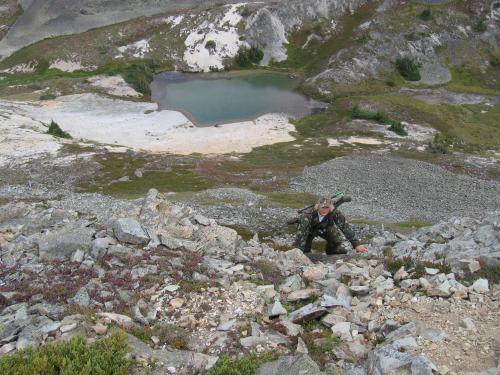
The thrill of the back country wilderness can be very appealing. Getting away from the masses in a breathtaking environment are some of the perks of bivouac hunting the alpine areas of North America.
Extraordinary wilderness has been an inseparable part of hunting for ages. Rugged mountains and basins have lured hunters with a promise of abundant wild game. Modern day hunters seek prime destinations for expedition-style wilderness hunting. Today the hectic pace of city life has made it necessary for man to unwind and free himself from the stress that turns his life into misery. It has intensified his desire to be away from the hustle and bustle of the urban concrete jungle to a destination, where he can relax in solitude packing away the troubles and pressures for at least some time. There can be no better way to achieve this goal than to go for a hunting trip in the deep wilderness of the forests. Being in the lap of nature enjoying the rugged landscape, trekking and tracking in the forests, matching skills against the sharp instincts of wild animals and bagging a trophy has a tremendous relaxing/rejuvenating effect on the hunter. He once more gets infused with vigor and vitality for a fresh bout with city life.
During a wilderness hunting trip, the hunter is able to enjoy the charming, picturesque landscape of visually capturing mountains, dense forest cover and crystal clear streams, all of which pamper the adventurous spirit. Setting up tents at the campsite, cooking food over a wood fire and generally living out of a backpack are all part of a hunting trip in the wilderness. Camping is done in remote locations devoid of electricity and plumbing. It is a unique experience to combat the vagaries of nature, on its own turf and learn the intricacies of wilderness safety.
Every avid hunter is a diehard outdoorsman and can vouch for the exhilaration and enjoyment experienced during a hunting trip. Everything else fades away. What remains is the thrill of pursuing the quarry, the adrenaline pumping chase and the intense satisfaction on bagging a trophy. Every part of the hunt invariably involves rigorous physical exercise that tones up the body and builds stamina. It also has a profound psychological effect on the hunter that serves to strengthen his abilities for unflinchingly tackling situations that may be physically and/or mentally challenging in other spheres of life too. It builds discipline, independence and also a respect for nature. Hunting teaches the value of the bountiful gifts of nature; something that is lost among the pressures of everyday life. Deadlines, work schedules and other usual things leave no room for appreciating such things in the rat race of day to day life.
The back country wilderness can be an intimidating place, high elevations, extreme weather conditions, and unforgiving terrain. All these obstacles can be an exhausting combination physically and mentally. Be sure to love challenge and view alpine hunting as just that, a challenge. There is a reason very few hunters do this style of hunting.
Before commencing on an alpine adventure, its best to research what you are going to encounter, survival skills, and what type of gear you need.
The Gear
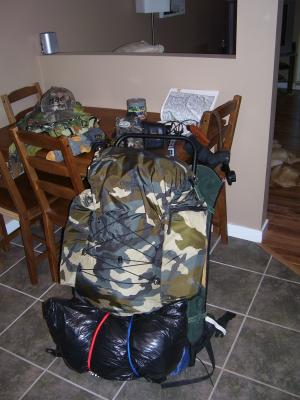
external frame pack
The gear required for trips to the wilderness plays a crucial part of expedition. Not only must it be high quality and tough, but being light is equally important, as you have to carry all of your items on your pack. Lets take a look of what type of gear you need:
Mountaineering boots or hiking boots, these must be light, tough and water proof. Make sure they fit correctly and are well broken in, as you cannot afford to have foot trouble when that is your way in and out of the back country. Wear smart wool socks in all seasons, they will wick away moisture from your feet preventing blisters and letting your feet breath.
Clothes, make sure you can handle wind, snow, rain and still function. I recommend a synthetic underwear like under armor. You can use gore tex or fleece outer layers for maximum performance. Cotton is not very efficient as when its wet there is no benefit to it
Pack, get a high quality tough, and light hunting back pack that can pack all of your gear. A 4500 size pack can fit what you need for a 3 day+ adventure. A rain poncho that can cover your pack is a good investment. Remember you will need to pack out your deboned game meat as well, this most likely will take another trip. Some hunters use llamas or horses to pack.
Tents and Bedding: I pack a light mountaineering tent from Columbia. Its called “frosty ridge.” I use a 2 man tent so my hunting partner can sleep in there as well. If going alone in mild climates, a bivy sac might fit the bill. For sleeping bags I recommend light bags with synthetic fill.
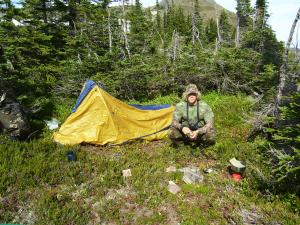
tenting in the alpine
Down is great because it is light but get it wet and its useless. I use a 0 degree(celcius) bag for the early season and a -20 degree(celcius)bag for the winter months. Don’t forget to use a thermarest bed roll. Nothing worse than sleeping on a jagged rock. For a pillow, you can roll up some clothes or use your jacket.
Water Purification, use either a filter pump or iodine drops to prevent getting sick from water in the wilderness. I can’t imagine anything worse than being sick on top of a mountain all the while losing weight and strength. A common thinking among people is that running water in streams is clean. That is false as Giardia is found in moving streams and rivers even in remote areas. It is a micro organism that causes intestinal cysts and other problems. A proper filter like the katadyn hiker will filter out micro organisms.
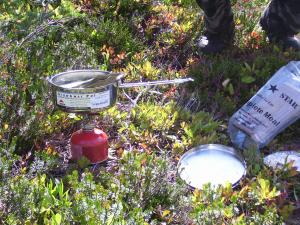
cooking in the backcountry
Cookware: I use a brunton raptor which runs on isobutene, its very small and light. If you can buy titanium as its way lighter than stainless steel and 25% lighter than aluminum. I bring a plastic bowl and spoon to eat out of.
Meals: I eat oatmeal for breakfast and snack on pepperoni, Deer jerky, trail mix, protein bars during the day. At night for dinner, I cook up an MRE, they include an entrée, applesauce, trail mix, cookie, and orange drink mix. A full meal. I cook the entrée in boiling water in the package it comes in. A spoon is provided so you can
save weight by not packing cutlery and dishes.
Hunting Gear: Good optics will save you a lot of walking, buy the best you can afford. A 10×40 power set of binoculars is optimal.
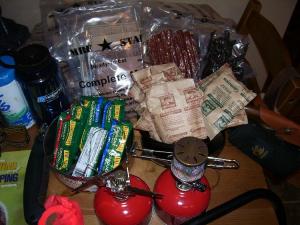 Optics are shakey when held in your hands if you use over 10 power. A headlamp is also a must item when embarking on a wilderness journey. Make sure you have a good scope on your rifle and use a range finder on your hunts. Spotting scopes can be a heavy luxury to have on a backpack hunt but lots of hunters use them.
Optics are shakey when held in your hands if you use over 10 power. A headlamp is also a must item when embarking on a wilderness journey. Make sure you have a good scope on your rifle and use a range finder on your hunts. Spotting scopes can be a heavy luxury to have on a backpack hunt but lots of hunters use them.
Conditioning: Don’t let the first time you hike up your mountain for the hunt be your first. What I mean is that you should be huffing it up and down the local hills and trails during the off season regularly with a pack. In order to prepare for the hunting season you should have a lot of running and hiking under your belt. At least 3x a week you should be doing some type of conditioning during the off season. Believe me, I thought I was in pretty good shape the first time I went up a 10 kilometer trail that climbed 2500’ with a 70lbs pack.
I never felt so fatigued, it could have literally ruined my hunt but I paced myself and took lots of breathers. The next time I went up, I felt a lot better and enjoyed the hunt more. If you hit the wall when you are hunting, you will not recover properly. It is better to pace yourself, instead of going balls to the walls on day 1 and then trying to recover when you are supposed to be hunting. Trust me, the better shape you are in the better hunting odds you will have.
You cannot be lazy or lethargic on mountain wilderness hunts, there is no room for it. If you are fatigued and lazy, you will not be able to stalk your game properly, cover ground, and not to mention the danger of being fatigued on top of a mountain.
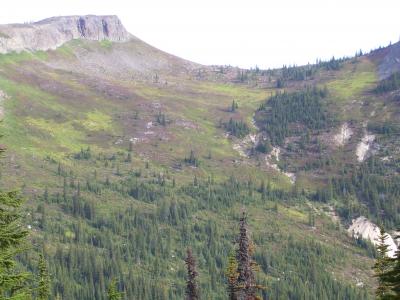
saddle formation
Strategies: In the alpine you want to be glassing bowls, saddles, and hillsides for deer and elk sightings. Try to avoid standing on peaks of mountains so you don’t skyline your silhouette. When glassing, try to keep hidden using rocks or ground cover. You will see most action during dawn and dusk. This is where good optics come into play, you should be watching between trees and in the timber pockets for movement. Usually after watching an area for 10 minutes I start to see movement if it is a good area. Don’t get frustrated, the animals are there just hard to spot. This is where pre season scouting comes into play. If you know for a fact that the game you are after is in the vicinity, you will have the confidence to wait until you spot them. To glass effectively you should do a quick glance of the area you are watching then go over it in a grid like fashion. Start left to right and then top to bottom. Then tackle another spot. Repeat until you find you quarry.
When you find a big game animal worth while going after, plan your stalk using landmarks. You need to know where you are at all times so you don’t blow the stalk. Mule deer bucks as well as most game, are best stalked from above. Slowly make your way across the mountain and stalk down to your animal.
If you are using a flat shooting rifle, you should be well practiced enough to take a 300 yard kill shot. Range finders are very helpful tools to eliminate the guess work in your shots.
For bow hunters, a 40 yard shot should be within your capabilities. Make sure you are well practiced in 3D shoots during the year so you know your abilities. Side hill and down hill shots are different than flat field. Be sure to have a level on your sight so you hold your bow level when taking that side hill shot on a once in a lifetime muley. If you fail to keep your bow level when shooting, you will launch the arrow to far left or right.
Watch a video of some alpine adventures
Caution: There is a great risk is that of high altitude sickness (mountain sickness) as a result of lack of oxygen. High Altitude Pulmonary Edema (HAPE), or High Altitude Cerebral Edema (HACE) is an emergency condition that can turn fatal if not treated quickly. So consider all factors before you plan your trip.

